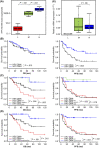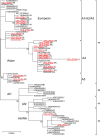Prognostic significance of human papillomavirus 16 viral load level in patients with oropharyngeal cancer
- PMID: 34382311
- PMCID: PMC8486212
- DOI: 10.1111/cas.15105
Prognostic significance of human papillomavirus 16 viral load level in patients with oropharyngeal cancer
Abstract
Human papillomavirus (HPV) infection in patients with oropharyngeal squamous cell carcinoma (OPSCC) is a major determinant for better prognosis. However, there remain HPV-positive patients who have poor outcomes. The stratification strategy for detecting high-risk patients among those with HPV-positive OPSCC has not been well delineated, especially for Asian patients. We undertook a retrospective cohort study on the survival rate of 89 Japanese patients diagnosed with primary OPSCC. The tumors were concurrently analyzed for the presence of HPV E6 DNA/mRNA, viral DNA load, p16 expression, viral physical status, and viral variant lineage. Human papillomavirus 16 viral DNA was found in 45 (51%) OPSCCs. Human papillomavirus 16 DNA-positive OPSCCs with higher viral load (classified as HPV16 DNA-medium/high OPSCCs) showed significantly favorable overall survival and progression-free survival compared with HPV16 DNA-positive OPSCCs with lower viral load (<10 copies/cell; HPV16 DNA-low OPSCCs) and HPV16 DNA-negative OPSCCs. E6 mRNA expression was observed in all HPV16 DNA-medium/high OPSCCs but not in HPV16 DNA-low OPSCCs. Notably, p16-positive and HPV16 DNA-negative/low OPSCCs showed significantly worse survival than p16-positive and HPV16 DNA-medium/high OPSCCs and resembled HPV-unrelated OPSCCs with regard to survival and risk factor profile. Although not significant, a trend toward shorter survival was observed for HPV16-integrated OPSCCs. Phylogenetic analysis revealed two major types of HPV16 variants termed Asian (A4) and European (A1/A2/A3) variants, but no difference in survival between these variants was observed. Altogether, these findings suggest that HPV viral load is a potentially informative factor for more accurate risk stratification of patients with OPSCC.
Keywords: Japanese cohort; human papillomavirus; oropharyngeal cancer; prognosis; viral load.
© 2021 The Authors. Cancer Science published by John Wiley & Sons Australia, Ltd on behalf of Japanese Cancer Association.
Conflict of interest statement
The authors declare no potential conflicts of interest.
Figures




References
-
- McDermott JD, Bowles DW. Epidemiology of head and neck squamous cell carcinomas: impact on staging and prevention strategies. Curr Treat Options Oncol. 2019;20:43. - PubMed
-
- Menezes FDS, Fernandes GA, Antunes JLF, Villa LL, Toporcov TN. Global incidence trends in head and neck cancer for HPV‐related and ‐unrelated subsites: a systematic review of population‐based studies. Oral Oncol. 2021;115:105177. - PubMed
-
- Taberna M, Mena M, Pavón MA, Alemany L, Gillison ML, Mesía R. Human papillomavirus‐related oropharyngeal cancer. Ann Oncol. 2017;28:2386‐2398. - PubMed
MeSH terms
Substances
Grants and funding
LinkOut - more resources
Full Text Sources
Other Literature Sources

